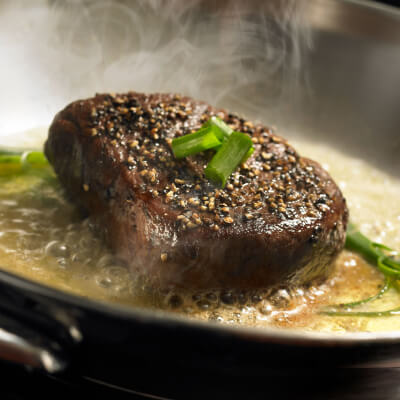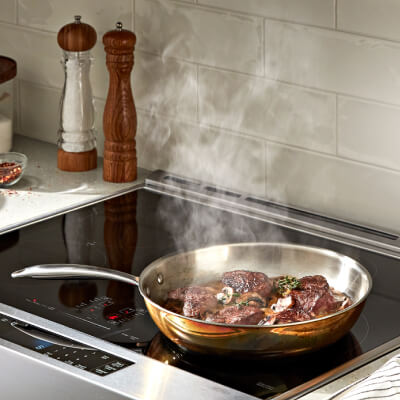
How to Sear and Cook Steak on the Stovetop
With a crispy, seared outside and a tender, juicy inside, a perfectly cooked steak is a delicious entreé to serve alongside a Twice Baked Duchess Potato or a unique and refreshing Blood Orange, Beet & Hazelnut Winter Salad. Making a steak on the stovetop allows you the high heat you need for a flavorful sear along with the ability to control the burner to make your steak to your liking.
Whether you are cooking flank steaks, New York Strip steaks or ribeyes, and no matter the level of doneness you prefer, searing and cooking a steak on the stovetop is a great way to enjoy a steakhouse-worthy dinner around your dining table. Follow this guide to help you learn how to sear and cook steak on your stovetop.


What is searing meat?
Searing meat simply means to cook the surface of it quickly, with intense heat. Pan searing, like with steak on a stovetop, uses high heat to seal in juices and create a delicious, crispy exterior. Searing is also one of the steps of sous vide cooking.
What is reverse searing steak?
Reverse searing involves first cooking the steak low and slow, such as in an oven, and then transferring the steak to a hot pan or cast-iron skillet to quickly sear both sides, locking in the flavor and juices right before serving. You can also do this when reheating steak to preserve as much tenderness and juiciness as possible.


How to Pan Sear Steak Step-by-Step
Pan searing steak on the stovetop involves a simple process that will ensure a flavorful and tender result. Follow the steps below to help you learn how to make a delicious steak dinner right in your kitchen.
Yields
1 steak
Ingredients
Your choice of cut of steak
Olive oil
Salt
Pepper
Freshly ground spices of your choice (optional)
Butter
Tools
Cast-iron skillet
Instant-read meat thermometer
Tongs
Cutting board
- Aluminum foil
Prep Time
- 40 minutes
Cook Time
- 10 minutes
Total Time
- 50 minutes
Step 1: Select a steak
The first step to making a perfectly seared steak on your stovetop is choosing the right cut. A thinner steak works best on the stovetop and won’t require finishing in the oven. Consider choosing a steak that is about one to one-and-a-half inches thick. It is also beneficial to choose a boneless steak, as bone-in steaks take longer to cook. Steaks with marbling are often the most flavorful for cooking on a stovetop and include cuts like New York Strip, ribeye and filet mignon.
TIP:
If you’d like to marinate your steak, start by patting it dry with a paper towel or salting it and leaving it in the refrigerator overnight. The longer you marinate the better. You can allow steak to marinate for up to 24 hours. Coarse cuts of meat do well with acidic marinades while more tender cuts are great for dry rubs. Select KitchenAid® refrigerators even come with an Under-Shelf Prep Zone that utilizes empty space beneath the shelf to create a prep zone ideal for marinating meats.

Step 2: Select your cookware
Once you have chosen a cut of steak, the next step is to decide on cookware. A skillet with a heavy bottom is the best option for cooking steak on the stovetop. Heavy-bottomed skillets include cast-iron and stainless steel. Cast-iron is the preferred choice because it has the ability to retain a set temperature for a long period of time, but stainless steel is a great option if you are going to scrape fond to create a pan sauce. Explore cookware options from KitchenAid brand to find the perfect fit for creating your savory steak dinner at home.

Step 3: Remove steak from refrigerator
The next step is to remove your steak from the refrigerator about 30 minutes before you plan to cook it. If the steak is too cold, you may overcook the outside and undercook the inside. Allowing the steak to rest outside the refrigerator for 30 minutes helps to ensure even cooking.
Step 4: Dry the steak
Next, pat the steak dry. Patting the steak dry before seasoning and cooking helps to stop the salt from melting and will keep the steak from creating steam when it hits the pan. If steam is created, you may not end up with the brown, crispy texture on the outside.

Step 5: Oil and season the steak
Brush the steak with olive oil and season with salt, pepper and your choice of freshly ground spices on all sides.
Step 6: Heat your cookware
Next, heat your selected cookware over high heat.
Step 7: Sear one side of the steak
Sear the side of the steak with the fat cap first, if it has one. Place your steak flat in the skillet and sear until it is a deep brown color, often about four to five minutes. Remember that the amount of time you cook your steak is also dependent on your desired doneness. If the steak does not move freely in the pan, but rather sticks to the bottom it is not quite done on that side.
Step 8: Sear the other side of the steak
Using the tongs, turn your steak to the other side and continue cooking for about two to three more minutes or until it is lightly browned.

Step 9: Add butter and herbs
While the steak continues to cook on this side, add a small amount of butter and any other herbs or spices such as fresh rosemary, freshly minced garlic, sprigs of thyme or for a bit of spice, fresh chili pepper. You can even make your own homemade butter for a fresh and delicious addition.
Step 10: Continue cooking
Continue cooking the steak, spooning the butter over top of it, until the internal temperature of the thickest part of the steak reaches about five to ten degrees shy of your final desired temperature. The steak’s temperature will rise about five to ten degrees during the resting phase. The safe minimum temperature for steak is 145° F according to the USDA guidelines — use a meat thermometer to check.

Step 11: Allow steak to rest
Transfer your cooked steak to a cutting board and loosely tent aluminum foil over it. Allow it to rest for about ten minutes. During this time the steak’s juices will redistribute evenly and you will reduce the amount of juice you lose when you cut into it.

Step 12: Slice and serve
When your steak is done resting, slice it against the grain. Consider serving it with the excess melted butter or drippings from the pan and alongside your favorite side dish.
Shop KitchenAid® ranges
Baking, broiling, sautéing and searing - your range helps you do it all. If you're looking for an upgrade, explore KitchenAid brand's range of gas, electric and dual fuel options with features like Even-Heat™ Technology that deliver the consistency and precision you need.


How long should I cook steak on the stove?
How long you cook the steak on the stove is dependent on your preference for doneness. The amount of time it will take to cook a steak also depends on the cut and the thickness. Steaks can be cooked anywhere from rare to well-done. A 1-inch rare steak takes about six minutes to cook on the stove and a well-done steak takes about twelve minutes.
Do you flip steak when cooking on the stove?
Although you may want to flip the steak while it is cooking, allow the steak to cook fully on one side before turning it. Once the steak can move about in the pan without sticking, it is ready to be flipped.


What pairs well with pan seared steak?
A pan seared steak pairs well with a variety of side dishes, depending on the theme of your meal or the flavors you have seasoned your steak with. Some options include homemade French fries, baked potatoes and crispy air fryer vegetables. Serve your steak alongside homemade vegetable noodles with this Zucchini Noodles with Tomato Butter Sauce recipe.
For a more casual feel but still an elevated taste, try these Thyme Roasted Parsnip Fries or for a comforting combination on a cold winter night, try this Spinach and Artichoke Mac and Cheese.
Explore KitchenAid® Cooktops
Designed to spark creativity in your kitchen, KitchenAid® cooktops come in a range of sizes and styles to fit your specific needs. KitchenAid® cooktops combine versatility, craftsmanship and performance to elevate your cooking experience and expand possibilities.